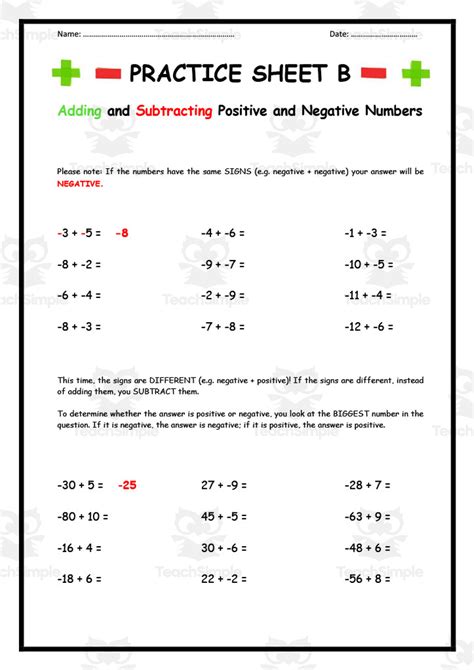Subtracting positive and negative numbers can seem like a daunting task, especially for those who are new to working with negative numbers. However, with a few simple rules and some practice, you can master this concept and become more confident in your math skills. In this article, we will explore the basics of subtracting positive and negative numbers, discuss some common pitfalls to avoid, and provide plenty of examples to help you understand the concept better.
Key Points
- Understanding the concept of negative numbers and their representation on the number line
- Learning the rules for subtracting positive and negative numbers
- Practicing with examples to build confidence and fluency
- Avoiding common pitfalls, such as sign errors and incorrect application of rules
- Applying the concept of subtracting positive and negative numbers to real-world problems
Understanding Negative Numbers

Negative numbers are numbers that are less than zero. They are represented on the number line to the left of zero and are denoted by a minus sign (-). For example, -3 is a negative number that is three units to the left of zero on the number line. To subtract positive and negative numbers, you need to understand how they interact with each other.
Rules for Subtracting Positive and Negative Numbers
When subtracting positive and negative numbers, you need to follow these simple rules:
- Subtracting a positive number is the same as adding a negative number. For example, 5 - 3 = 5 + (-3) = 2.
- Subtracting a negative number is the same as adding a positive number. For example, 5 - (-3) = 5 + 3 = 8.
These rules may seem counterintuitive at first, but they are based on the concept of negative numbers and how they interact with positive numbers.
| Operation | Example | Result |
|---|---|---|
| Subtracting a positive number | 5 - 3 | 2 |
| Subtracting a negative number | 5 - (-3) | 8 |
| Subtracting a negative number from a negative number | -5 - (-3) | -2 |

Practicing with Examples

Now that you understand the rules for subtracting positive and negative numbers, let’s practice with some examples:
- 2 - 5 =? (Answer: -3)
- -3 - 2 =? (Answer: -5)
- 8 - (-2) =? (Answer: 10)
- -1 - (-4) =? (Answer: 3)
As you can see, subtracting positive and negative numbers is a straightforward process once you understand the rules. With practice, you can become more confident and fluent in your math skills.
Avoiding Common Pitfalls
When subtracting positive and negative numbers, there are some common pitfalls to avoid:
- Sign errors: Make sure to pay attention to the signs of the numbers you are working with. A negative sign can change the result of the operation.
- Incorrect application of rules: Make sure to apply the rules correctly, depending on the operation you are performing.
By avoiding these common pitfalls, you can ensure that you get the correct result and build your confidence in working with positive and negative numbers.
What is the difference between subtracting a positive number and subtracting a negative number?
+Subtracting a positive number is the same as adding a negative number, while subtracting a negative number is the same as adding a positive number.
How do I avoid sign errors when subtracting positive and negative numbers?
+Make sure to pay attention to the signs of the numbers you are working with and apply the rules correctly, depending on the operation you are performing.
Can I use real-world examples to practice subtracting positive and negative numbers?
+Yes, using real-world examples can help you understand the concept better and make it more relatable. For example, you can use temperatures, bank account balances, or stock prices to practice subtracting positive and negative numbers.
In conclusion, subtracting positive and negative numbers is a straightforward process once you understand the rules and practice with examples. By avoiding common pitfalls and applying the rules correctly, you can build your confidence and fluency in working with positive and negative numbers. Remember to always pay attention to the signs of the numbers you are working with and to apply the rules correctly, depending on the operation you are performing. With time and practice, you can become more comfortable and proficient in subtracting positive and negative numbers.



